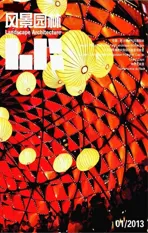导读
2013-12-19撰文布莱恩布雷翻译狄帆校对杨云峰
撰文 (美)乔 · 布莱恩 · 布雷 翻译 狄帆 校对 杨云峰

图01 路易斯·劳瑞斯和乔·布莱恩·布雷博士在参观密歇根的一个露天煤矿。Fig.01 Luis Loures and Dr. Burley visiting a surface mine in Michigan.
案例分析法是了解规划设计的重要途径。其有效之处在于与实际场地的关联性,不足之处则在于概念性的设计案例有诸多的内在不足。案例分析通常并不能表明因果关系,且很难解释信息的变化性。然而,案例分析能够为规划设计的深化推进提供重要的见解。
马克·弗朗西斯(Mark Franics)在2001年出版了一本关于案例研究的著作。这本书应该作为规划设计领域分析家和学者的标准读物。
成功的案例分析通常开始于提出一个问题、想法或者主张,并且提供一条论证或者驳斥这一问题/想法/主张的途径。例如,一个研究者可提出诸如“某一设计概念可导致优秀设计”的主张,随后应该通过某一案例论证这一主张的存在与否——若无法得出类似结论,该案例分析则是不完整的。接下来,研究者需要研究并认定设计的质量。判定依据包括调查、评价、公开的数据、指引以及现场调研。
如果研究者无法找到衡量设计质量的方法,那么对于案例的分析研究就仍然是未完成的。但是,如果能够鉴别概念的存在与否,或者是设计的质量,研究者则能通过选择需要研究的案例来鉴别概念的存在与否与设计质量。接下来,研究者可以讨论该概念为设计所带来的好处,并得出设计概念是否能带来优秀设计的结论。案例分析并不是统计方法,不排除有例外情况的存在。分析的结果可能引出更多的问题。糟糕的案例分析通常并不遵循这一过程,其结果也是值得怀疑的。好的案例分析则能提供支持结论的证据。
路易斯·劳瑞斯的工作代表了成功的案例分析方法。他仔细的建立完成其研究的计划。他访问了每个场地(美国、加拿大、德国、荷兰以及葡萄牙)。他的目标是整理一系列能够从这些案例分析中得到的规划设计原则。这些原则的目的则是建立一系列帮助规划师和设计师从事后工业景观项目实践的准则。因此,劳瑞斯博士必须采取场地调研,采访设计师,鉴别以及提取规划设计原则的方法来完成他的案例分析。如果能做到这点,他的案例分析则是成功的。我们并不知道能得到多少设计原则,或是他们在这6个案例分析中的重叠情况①。设计准则的清单可长可短。能得到更多的设计原则吗?很可能。但是该清单就只有劳瑞斯博士所发现的设计原则。其他人会用到这份清单吗?这取决于在后工业遗址上工作的规划设计师的选择。对于任何分析来说,作者都期待其研究成果能为专业人士所用。
对于这份准则清单而言,劳瑞斯博士能通过调研的方式进行统计学的研究。这份清单使得他能进行更深入的研究(2010)。这份更深入的研究能表明案例分析及由此产生的更专注的研究之间的关系。没有这份准则清单的话,我们将无法得到适用于研究后工业景观的子集方法。
注释:
①劳瑞斯博士的原文提供了6个案例,限于篇幅,译者删除了其中3个国内读者比较熟知的案例。
乔·布莱恩·布雷/博士/美国密歇根州立大学规划设计建设学院风景园林系教授/美国风景园林师协会会士
译者简介:
狄帆/1986年生/男/南京林业大学城市规划与设计硕士/哈佛大学设计研究生院风景园林学系硕士生
校对简介:
杨云峰/1981年生/博士/南京林业大学风景园林学院讲师/美国密歇根州立大学访问学者/本刊特约编辑/YouthLA核心编辑 (南京 210037)
The case study approach is a valuable technique to understand the planning and design of space. Its strength lies in the aspect that it is connected to real places and sites. Its weakness is that the experimental design can be quite flawed.Case study approaches usually do not illustrate cause and effect and rarely can explain the variance in the information. But the case study approach can yield insight into the type of questions and research that can be further explored in planning and design.
Mark Franics (2001) wrote an excellent primer concerning the case study method. This material should be standard reading for investigators and scholars in planning and design.
Successful case studies usually start by posing a question, idea, or belief, and providing a path to validate or refute findings based upon the question/idea/belief. For example an investigator may pose a question or belief such as “having a design concept leads to quality design.” Then the scholar must be able to define and identify the existence or non-existence of a concept in a project—if it is not possible to determine if a design has a concept or not, then there is no way the study can be accomplished. Next the scholar must be able to define and identify quality in design. Sources could include surveys, critiques, published accounts,an index, and site visits. If the scholar cannot find a method to assess quality, then again the study is unable be accomplished. But if it is possible to identify a concept or lack of concept and it is possible to asses the quality of the design, then the scholar can select the projects (case studies) to be examine, identify the concept or lack of concept in the design, and assess the quality of the design. Then the scholar can discuss merits of having a concept in a design and does it lead to quality design? They can then render their conclusion about whether having a design concept leads to quality design.The approach is not statistical. There may also be exceptions to the general findings. The results may lead to new questions and the thoughtful crafting of experiments to give more empirical results.Poorly conducted case studies many not follow this approach and thus the findings may be very suspect. A good case study thoughtfully builds and presents evidence for the findings.
Luis Loures’ work illustrates the successful case study methodology. Dr. Loures carefully developed a plan to complete his study. He visited each of the sites (United States, Canada,Germany, Netherlands, and Portugal) for his investigation. His goal was to identify a list of planning/design principles that he could extract from the case studies. He engages the designers of these projects to extract the principles. The purpose of the principles was to develop a list of criteria to assist planners and designer to consider in the redevelopment of post-industrial landscape projects. Thus for his case study approach he needed to be able to visit the sites, engage in communication with the designers, and be able to identify and extract a list of planning and design principles. If he could do this, he could successfully conduct his study. There was no notion of how many principles would be discovered or how they might overlap between the six case studies. The list could be lengthy or short. Could there be more principles? Probably yes. But his list is what he discovered. Will anyone use his list? It remains the choice of planners and designers working on post-industrial land transformation projects.For any research projects, acceptance and use by professionals is always hoped for, but a great unknown.
From this list of principles, Dr. Loures can conduct statistical analytical research through surveys. The list provided a place for Dr. Loures to start his deeper investigations (2010). The deeper investigations illustrate a link between conducting a case study and then employing the results of the case study to generate a more focused study.Without the list of principles derived the case study,further investigations would not contain a suitable subset from which to examine post-industrial landscapes.
Finally, I have known Dr. Loures for 9 years.He came to Michigan State University in 2007 to study surface mining (Fig.01), post-industrial land transformation, and to visit potential case study sites. He finished his PhD in 2011 and has been an instructor and professor in Portugal for several years. Dr. Loures is an example of the type of extensive PhD. Research that is expected and conducted by landscape scholars in the West. Dissertations should generate 4 to 7 peer reviewed papers. And the effort takes years of data gathering and analysis. Recently, Dr. Loures has been publishing papers from his PhD and initiating new studies in landscape architecture.In 2012, Dr. Loures was invited back to Michigan State University to participate in critiques and give a lecture concerning post-industrial land development. It is a pleasure to have Dr. Loures have one of his papers submitted to us and successfully pass the review process to be published.
Literature Cited
Francis, M., 2001. A Case Study Method for Landscape Architecture. Landscape Journal, 19(2): 15-29.
Loures, L., 2010. Postindustrial Land Transformation Planning And Design: East Bank Arade River, Lagoa- Case Study. PhD. Urban Planning, Universidade do Algarve, Faro, Portugal.
